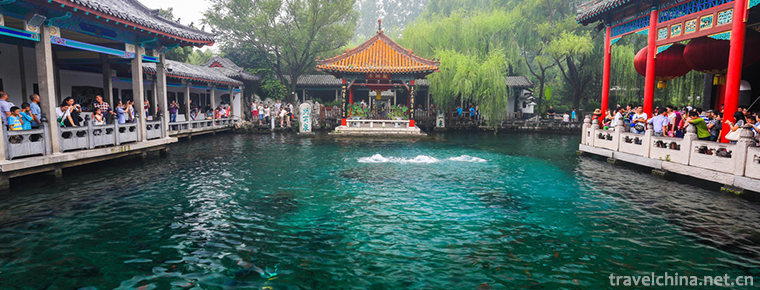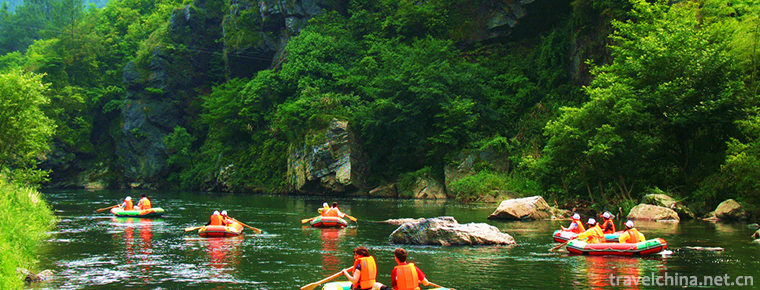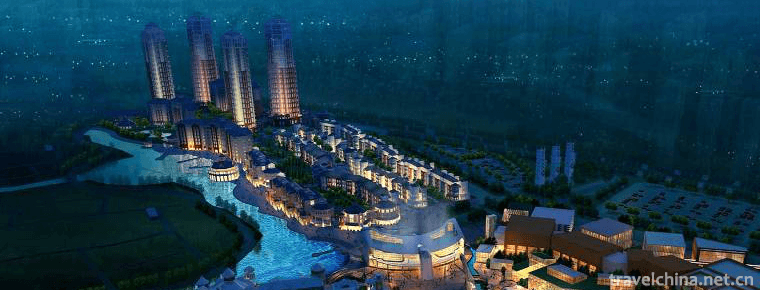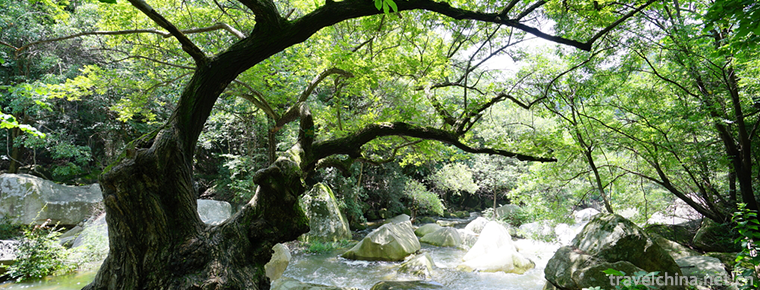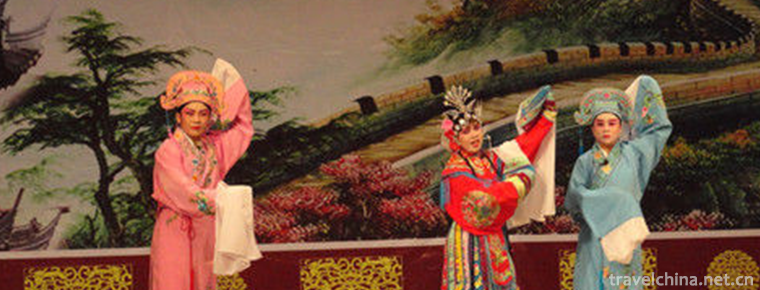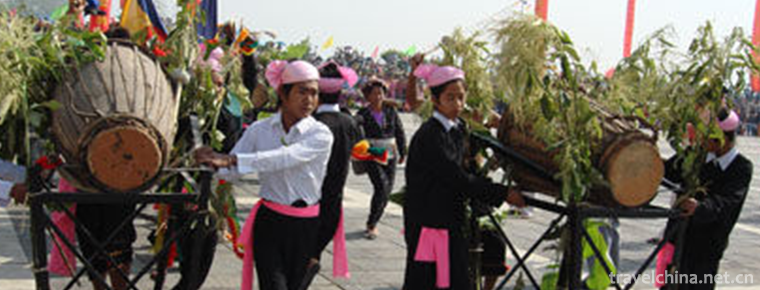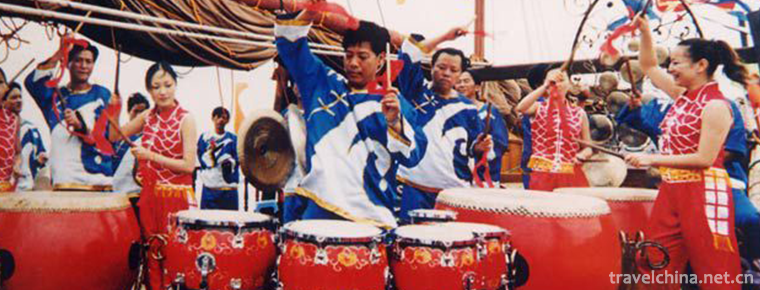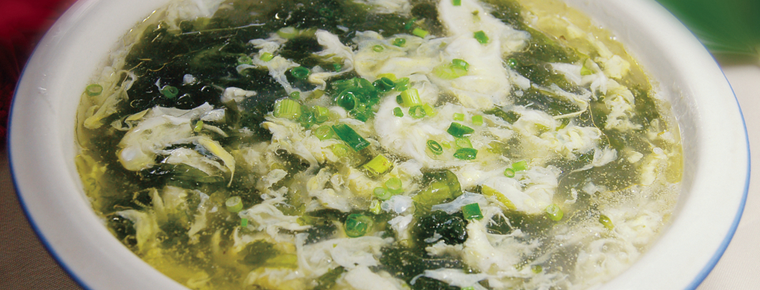Jiufeng Mountain Scenic Area
Jiufeng Mountain Scenic Area
Jiufeng Mountain is located in Dabao Township in the northwest of Pengzhou. It is about 97 kilometers away from Chengdu, with an altitude of more than 3315 meters. It is the crown of Pengzhou mountains, a sacred and mysterious area, and a place shared by Taoism and Buddhism. It is composed of Jiufeng Mountain, Yinchanggou and danjingshan. On the top of the peak is the Leiyin temple built in the Ming Dynasty.
On sunny days, sunrise, sea of clouds and Buddha light can be seen. On cloudy days, we can see the wonder of "waterfall cloud". Mainly developed the Yinchanggou Scenic Spot with concentrated landscape in the Northeast foot.
origin
The name of nine peaks is derived from nine peaks. According to the annals of Pengxian County, Jiaqing, Qing Dynasty: "in the northwest of China, there are nine peaks standing on the sky, which is actually the crown of all the mountains in Pengyi, so it is named." What is the shape of Jiufeng? According to the records of Jiaqing, the nine peaks are white dragon, rosefinch, flame and Tianya in the northeast, backlight in China and Japan, and Xianren, Huanglong, Yuanwu and Baihu peaks in the southwest
History of development
The nine peaks are surrounded by clouds and mist, and high into the sky. When the ancient Shu people did not know the relationship between the sun and the earth, they thought that the high and straight nine peaks blocked the way of the sun and the moon. They called the canyon between the nine peaks as "Menggu" (the place where the sun sleeps). Some people who study the classic of mountains and seas say that Jiufeng Mountain is the "Lingshan" in the western classic of great waste. Wupeng, Wuwei, Wuji, Wugu, Wuzhen, Wuli, Wudi, Wuxie, Wuluo and so on, went to the world from here. All kinds of drugs are growing here. When they go to the world, they should also) collect some to treat people. Therefore, the mountain is also known as "ladder", "fairy road" and "fairyland on earth". It is said that this mountain is a mountain where "climbing is the spirit", "climbing is God", "climbing can not die", "climbing can make wind and rain", "producing immortal medicine".
In history, many monks and sages stopped here. Since the song, yuan, Ming and Qing Dynasties, the story of the founder of Jiufeng has been spreading. In the past, Jiufeng Mountain awed the officials and the people. It seemed that they sincerely sought things from the mountain, but they defended the people to eliminate disasters, prayed for rain and prayed for children. The temple materials are also different. The temples in the mountains used too much iron tile and huge wood, which became an ideal raw material for legislation and steelmaking during the Great Leap Forward period.
Since 1985, the mountain has been developed into a provincial-level natural scenic spot. Religious circles are actively restoring temples and adding infinite luster to Jiufeng Mountain.
Main attractions
Flame peak
Among the peaks, the flame peak is particularly peculiar. During the period, there are deep canyons, swarms of waterfalls, clear springs, rhymed mountains and islands, colorful primeval forests, unpredictable cloud sea and Buddha light; azaleas are in full bloom in spring, as bright as the morning glow, and in winter, they are wrapped in red and enchanting. The Daoists and Buddhists vied for occupation. In the Northern Song Dynasty, it was already a resort in Western Sichuan. The flame peak became the synonym of Jiufeng Mountain. The Jiufeng Mountain mentioned by later generations does not refer to the nine peaks, but refers to the flame peak.
Tourism information
traffic
Chengdu North railway station, Guanghan, Xindu and Dujiangyan have direct tourist buses to Pengzhou. Chengdu and Pengzhou also have direct tourist buses to Jiufeng Mountain.

Jiufeng Mountain Scenic Area
-
WeChat
WeChat is a free application that Tencent launched on January 21, 2011 to provide instant messaging services for intelligent terminals
Views: 199 Time 2018-11-13 -
Jinan World First Spring Scenic Area
Jinan World No. 1 Spring Scenic Area, located in the center of Jinan City, Shandong Province, is a national AAAAA-level tourist attraction, national key park, advanced unit of national spiritual civil
Views: 202 Time 2018-12-08 -
Old Stork River Drifting
Xixia Guanhe Drifting Scenic Area is a national AAAA-level tourist attraction and a part of Funiushan World Geopark in Nanyang, China. Xixia County, Nanyang City
Views: 135 Time 2019-01-29 -
Wuhan Haichang Polar Ocean World
Wuhan Haichang Polar Ocean Park is the first Ocean Park constructed by Haichang Group in central China. It is the fifth large-scale theme park covering the concept of polar and ocean
Views: 205 Time 2019-02-24 -
Longtan Valley Ecological Scenic Spot in Xixia
Longtanggou Natural Ecological Scenic Area is located in Shuanglong Town Huashan Village, Xixia County, the hinterland of Funiu Mountains, Henan Province. It is 30 kilometers away from Xixia County
Views: 241 Time 2019-02-25 -
Taoist Drama
Taoist sentiment is a category of traditional Chinese folk art. It originated from Taoist songs such as Chengtian and Jiuzhen in Tang Dynasty. The Southern Song Dynasty began to accompany with fishing
Views: 289 Time 2019-04-25 -
Water Encouragement
Water drum dance is a kind of popular dance spread between the De'ang and Miao nationalities. It combines water, drum and dance to worship ancestors, pray for good weather and peace in villages. Howev
Views: 155 Time 2019-06-15 -
Zhoushan gongs and drums
Zhoushan gongs and drums are the representatives of traditional folk art in Zhoushan City, Zhejiang Province. They are based on gongs, drums, cymbals and clappers, with silk bamboo, magnificent sound
Views: 128 Time 2019-08-10 -
Seaweed and Egg Soup
Porphyra and egg flower soup is a kind of instant soup. It is a traditional after meal soup in Sichuan. Its main ingredient, Porphyra and egg, have high nutritional value. It is widely loved because o
Views: 135 Time 2020-03-18 -
Cuiping Mountain Park
Cuipingshan Park, located in the northwest of Yibin City, Sichuan Province, is a famous urban forest park integrating scenic spots and forest scenery. It is mainly composed of Cuiping mountain and Zhenwu mountain.
Views: 151 Time 2020-10-16 -
Dispute on the meaning of Cheongsam
Under the influence of the Qing Dynasty's Qiren's robes, women's gowns have been referred to as cheongsam since the Republic of China. Due to the influence of the environment at that time, most people know that the women of the Manchu and Qing Dynasty had their own cheongsam,
Views: 147 Time 2020-12-11 -
Sports in Yibin
In 2019, Yibin sports team (member) won 4 world-class gold medals, 15 national gold medals, 30 provincial gold medals, 38 silver medals and 41 bronze medals. The annual sales of sports lottery tickets reached 410 million yuan, and 15 million yuan of public w
Views: 348 Time 2020-12-18

